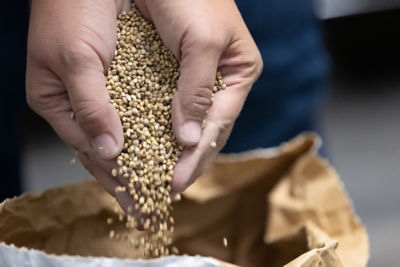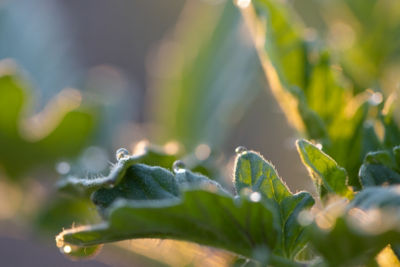Click here to download a PDF version of this spotlight.
» A change in the scientific name of the pathogen that causes leaf mold on tomatoes has resulted in a change in the code that seed companies will use when referring to resistance to that disease.
Leaf mold, also known as gray leaf mold and tomato leaf mold, causes lesions on the leaves, premature defoliation, and yield reductions in tomatoes. The disease is a problem on tomatoes grown in protected culture systems (greenhouse and high tunnel) because it is favored by the warm temperatures and high humidity conditions often associated with this type of production. The International Seed Federation (ISF) recently changed the abbreviation that seed companies use for the disease/pathogen from Ff to Pf because of a change in the scientific name of the pathogen. 1,2,3
 Figure 1. (A) Rhizobium root nodules on pea roots. (B) An individual nodule on a bean root. Whitney Cranshaw, Colorado State University, Bugwood.org.
Figure 1. (A) Rhizobium root nodules on pea roots. (B) An individual nodule on a bean root. Whitney Cranshaw, Colorado State University, Bugwood.org.
PATHOGEN NAMES
When an organism, such as a plant or fungus, is first described in the scientific literature, it is given a unique species name consisting of the name of the genus it belongs to and the species epithet. This two-part name is often referred to as the organism’s scientific or Latin name. For example, the scientific name of the species of the cultivated tomato plant is Solanum lycopersicum. The name is italicized to show that this is the scientific name. The rules used in naming plants and fungi are set down in the International Code of Nomenclature for algae, fungi, and plants. 4 The scientific name should provide information about the genetic relatedness of the organism to other similar organisms.
Organisms with the same genus name should be more closely related to each other than they are to organisms in other genera, and members of the same species should be more closely related to each other than they are to other species in the genus. The rules of nomenclature also indicate how the name of an organism can be changed if it is determined that the name does not accurately reflect what is known about its relatedness to similar organisms. The fungus that causes leaf mold of tomato was first described in 1883, and it was named Cladosporium fulvum because it had similar characteristics to other species of Cladosporium. In 1954 the fungus was transferred to a new genus, Fulvia, because more detailed information about the fungus distinguished it from Cladosporium, and the fungus was renamed Fulvia fulva. In 2003, mycologists decided that new genetic data and microscopic characteristics of the genus Fulvia were not distinctive enough from the genus Passalora to separate the species into two different genera. Species in Fulvia were transferred into Passalora, and the leaf mold pathogen was renamed Passalora fulva. 5,6 Over the next few years, plant pathologists, extension specialists, and other plant care professionals started using the name Passalora fulva for the pathogen. However, this is not the end of the story; stay tuned.
WHY NAMES MATTER
Seed companies, regulatory agencies, plant diagnosticians, and other plant professionals use the scientific names of pathogens to clarify what organisms they are referring to, because common pathogen and disease names can vary from country to country. Seed companies use the scientific names, and the associated acronyms (codes), when mentioning the resistance responses of crop varieties. The International Seed Federation (ISF) maintains a list of the currently accepted scientific names and codes so that pathogen designations can be consistent across seed companies.3 A committee within ISF, composed of appropriate specialists and experts, monitors scientific publications for proposed name changes of plant pathogens that are of interest to the commercial seed industry. When a new name is published, the committee evaluates the use of that new name over several years to determine if the scientific community has accepted the name change. When the use of the new name is well established, the committee can decide that the ISF-recognized name and code for the pathogen should be updated to reflect the change. The date that the change will take effect is usually set several years in the future to give seed companies time to make the change in seed catalogs, advertising materials, and other documents where they refer to a variety’s disease resistance characteristics.
The seed industry has been using the name Fulvia fulva for the tomato leaf mold pathogen, and the ISF standard code has been Ff for many years. Passalora fulva has now become the widely used name for the leaf mold pathogen in extension articles and other scientific publications. So, the ISF committee decided to recognize the name change and notified the seed industry that the name Passalora fulva and the code Pf would become the standard in 2022. This means that many seed companies will start using the abbreviation Pf when referring to the resistance of tomato varieties to leaf mold.3
Interestingly, a study published in 2017 reevaluated the genetic relationships of the group of fungi to which Passalora belongs. Based on new data, the authors of this study recommended that the name of the leaf mold pathogen be changed back to Fulvia fulva. 5 This conclusion has not been widely adopted by the scientific community and not yet considered by ISF. Seed companies will likely continue to follow current ISF guidlines for this pathogen to minimize confusion and promote consistency.
SYMPTOMS
As the name indicates, leaf mold primarily affects tomato leaves. Symptoms usually appear first on older leaves where pale green to yellowish spots develop on the upper leaf surface. The spots turn a brighter yellow, and the lesion margins are not well defined (Figure 1a).1 An olive-green to purple, velvety, fungal growth (mold) develops in the lesion area on the underside of the leaf (Figure 1b).1,7 The lesions can enlarge and coalesce when severe. The affected leaves can curl, wither, turn brown, and prematurely drop from the plants. The disease can sometimes affect petioles, fruit stems, flowers, and fruit. Infected flowers turn black and fall off. Fruit lesions appear as smooth, black areas that become sunken, dry, and leathery with age.1,7
CYCLES AND CONDITIONS
Cultivated and wild species of tomato are the only known hosts of P. fulva, although some solanaceous weed species may also be hosts. The leaf mold pathogen overwinters in crop residue and as spores and sclerotia (survival structures). The spores of the pathogen are spread primarily by wind and splashing water, but also by tools and on the clothing of workers. The pathogen can also be seedborne. Infection and disease development are favored by high humidity and moderate temperatures. Relative humidity (RH) levels of 75 to 90% are needed, with an optimum RH of 85%. The disease develops at temperatures between 40° and 90°F (4° and 32°C), with the optimum between 72° and 76°F (22° and 24°C). The disease rarely occurs at temperatures below 50°F (10°C). New spores can form within ten to twelve days after infection, and there can be multiple cycles per season. 1,2,7
MANAGEMENT
Resistance to leaf mold has been characterized in tomatoes. There are many races of Passalora fulva, and no tomato variety has resistance to all known races. Therefore, disease resistance should be used in conjunction with other disease management strategies.2,7 Genetic resistance is a first layer of protection against Pf. The Cf-9 resistance gene has been effective for years, and with new deployed resistance genes, resistance can continue to be important to help in the management of leaf mold. Sanitation is an important management tool for leaf mold.
Clean and sanitize greenhouse surfaces using steam, diluted bleach, or sanitizing solutions. Stakes, trellises, and other equipment should also be sanitized before reuse. 1,2,7
Avoid overhead irrigation, and promote good airflow in the canopy by using lower planting densities and open staking and pruning techniques. In protected culture, use ventilation for good air circulation, open vents on greenhouses or roll-up sidewalls on high tunnels to keep humidity levels low.1
Foliar applications of fungicides can help manage leaf mold caused by Passalora fulva (also listed as Fulvia fulva and Cladosporium on some fungicide labels). Applications should begin before infection occurs when conditions are favorable for disease development. Repeat applications according to label instructions.7 It is important that applications cover both upper and lower leaf surfaces.2,8
To help prevent the development of fungicide resistance in the pathogen, alternate applications using fungicides with different modes of action. Several fungicides are registered to help manage leaf mold on tomatoes. Check regional production or pest management guides for current lists of registered products. For protected culture, make sure that the product is registered for use in the greenhouse or high tunnel systems. 8,9
SOURCES
1 Jones, J. B. and Jones J. P. 2014. Leaf mold. Pages 34-35, in: Compendium of Tomato Diseases and Pests, 2nd Ed. Jones, J., Zitter, T., Momol, T., and Miller, S. Eds. St. Paul, MN.
2 Lewis Ivey, M. and Sidhu, J. 2015. Tomato leaf mold. Louisiana Plant Pathology; Disease Identification and Management Series. Pub. 3455.
3 International Seed Federation (ISF). 2022. Recommended Codes for Pest Organisms in Vegetable Crops. January 2022.
4 Turland, N. et al. 2018: International Code of Nomenclature for algae, fungi, and plants (Shenzhen Code) adopted by the Nineteenth International Botanical Congress Shenzhen, China, July 2017. Regnum Vegetabile 159. Glashütten: Koeltz Botanical Books.
5 Videira, S., Groenewald, J., Nakashima, C., Braun, U., Barreto, R., de Wit, P., Crous, P. 2017 Mycosphaerellaceae – chaos or clarity? Studies in Mycology 87:257–421.
6 Braun, U., Crous, P. W., Dugan, F. M., Groenewald, J. Z., and de Hoog, G. S.2003. Phylogeny and taxonomy of Cladosporium-like hyphomycetes, including Davidiella gen. nov., the teleomorph of Cladosporium s. str. Mycol. Prog. 2:3-18.
7 Jonson, A. and Grabouwski, M. 2015. Leaf mold of tomato. University of Minnesota Extension. https://extension.umn.edu/diseases/leaf-mold-tomato.
8 Egel, D. 2021. Tomato leaf mold diseases. Purdue Vegetable Crops Hotline. Issue 696.
9 Dittmar, P., Agehara, S., and Dufault, N. 2022. Vegetable Production Handbook of Florida 2022-2023. UF-IFSA. Websites verified 9/1/2022
ADDITIONAL INFORMATION
For additional agronomic information, please contact your local seed representative.
Performance may vary from location to location and from year to year, as local growing, soil and weather conditions may vary. Growers should evaluate data from multiple locations and years whenever possible and should consider the impacts of these conditions on the grower’s fields. The recommendations in this article are based upon information obtained from the cited sources and should be used as a quick reference for information about vegetable production. The content of this article should not be substituted for the professional opinion of a producer, grower, agronomist, pathologist and similar professional dealing with vegetable crops.
BAYER GROUP DOES NOT WARRANT THE ACCURACY OF ANY INFORMATION OR TECHNICAL ADVICE PROVIDED HEREIN AND DISCLAIMS ALL LIABILITY FOR ANY CLAIM INVOLVING SUCH INFORMATION OR ADVICE. 6811_56150
Published 10/10/2022
Bayer, Bayer Cross, Seminis & Leaf Design®, and Seminis® are registered trademarks of Bayer Group. All other trademarks are property of their respective owners. © 2022 Bayer Group. All rights reserved.




